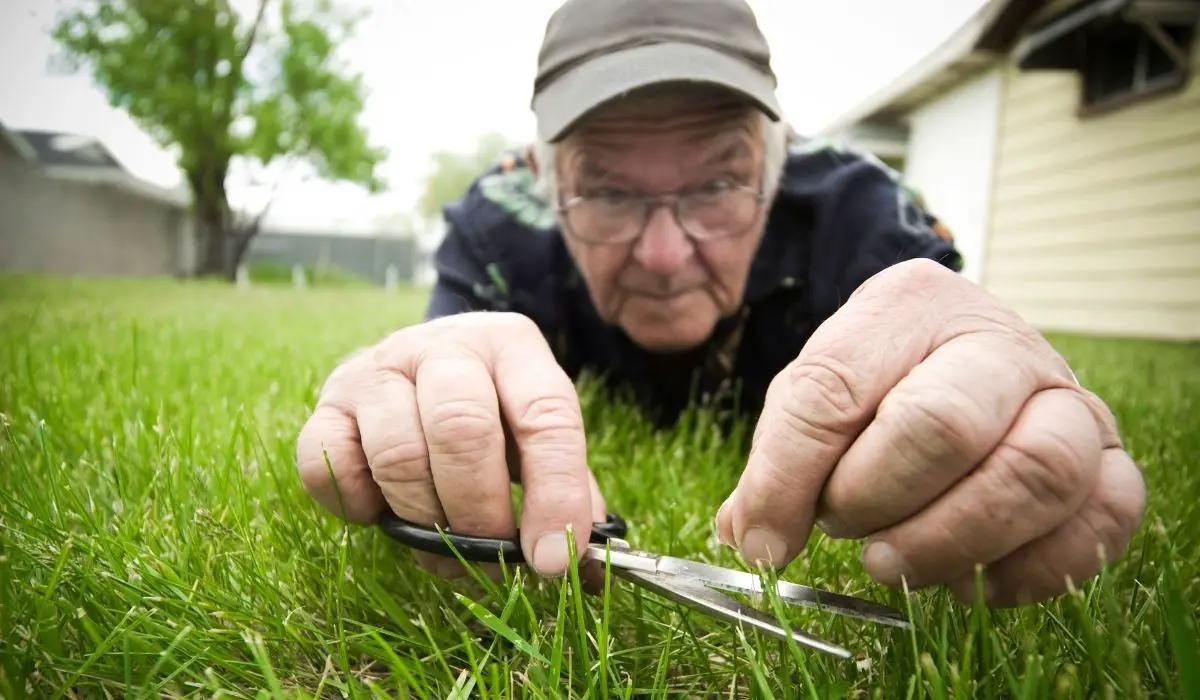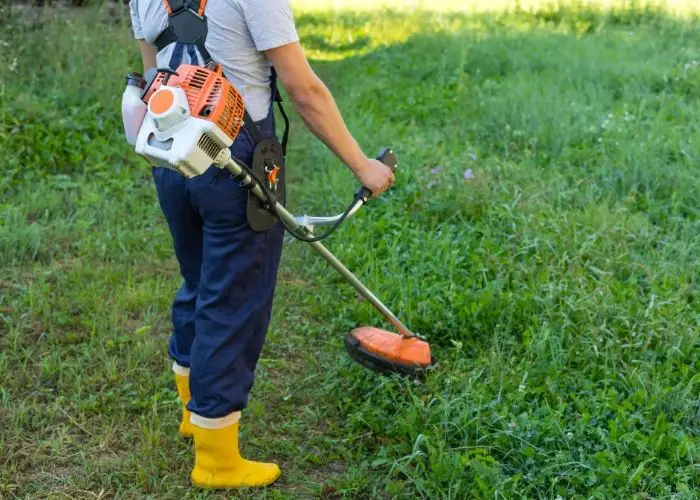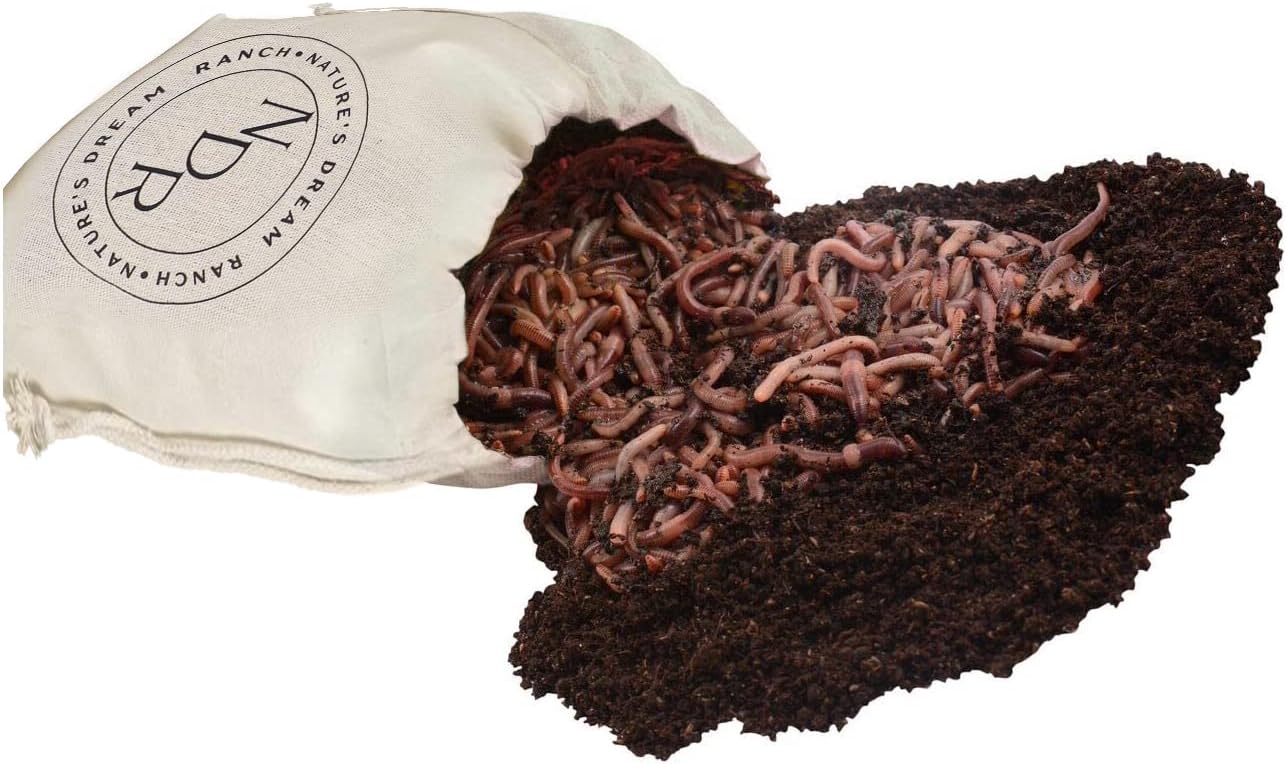Last Updated on December 27, 2022 by Griselda M.
Lawn maintenance is a bit of a pain. Generally, as a lawn gets older, it will, much like a human, get bald spots. Overseeding is necessary to maintain an even lawn for non-creeping grasses. In this article, we will look at how you can overseed your lawn to keep it beautiful and lush specifically focusing on how short to cut grass before overseeding, and then what to do after this.
What is Overseeding?
Overseeding refers to a method by which we make a lawn fill gaps and thicken to be lush and rich. Typically, we cut the grass as short as possible, and then aerate the lawn with some mechanism that will make holes in the grass. We scratch any bare patches to make the soil loose and then use lawn seed to cover the lawn in the seed.
The seed is then watered into the ground, and allowed to germinate. The time of year is important – you cannot do this in the summer heat, so it is a spring task for northern regions that have cold winters, and a spring and fall task for warmer climates.
Don’t Overseed Too Soon
Generally, my trick with overseeding was always to do it when I start seeing the first wild grass seeds coming up in patches on the lawn. This indicates that the climate is right for germination. If you overseed too early, birds will just peck up all of your expensive grass seed.
Why You Shouldn’t Overseed When The Weather Is Cold Or Wet?
Grass germination is triggered by increasing temperature and moisture in colder climates. Hence waiting for the weather to warm sufficiently so that grass can germinate is important. Again, you must remember that in colder weather it is important to let your grass grow a bit longer so that it has enough leaf surface area to keep its roots alive! Hence if it is cold and wet, you cannot cut your grass short – and short grass is essential for the preparation of overseeding.
Read more about Should I Bag My Grass Clippings After Overseeding?
Don’t Overseed If Your Soil Is Very Dry
Overseeding is the process of adding seed to existing turf. If your soil is too dry, seeds will not germinate and will die or get eaten by birds. I normally try to irrigate the lawn when I overseed.
I have actually got rid of my lawn because all of this fiddling around irritated me so much and now I use that space to produce healthy food for myself. However, when I did have a lawn I found that watching the weather forecast, and timing the overseeding for a patch when there were two weeks of wet gentle spring rain worked very well.
How Short To Cut Grass Before Overseeding?
Generally, I would cut the grass as short as possible. You will see that in some cases this will actually cut right into the turf and create bald patches in your lawn – this is fine – the grass seeds will correct these and this helps to even your lawn surface out. Set your lawnmower on its lowest setting.
My lawnmower is a bit of a beast, so this really makes a mess. Churning the soil up a bit really helps with the next steps. I would suggest you try to cut the lawn so that the grass is about an inch long.
Tips On How To Overseed Your Lawn
The method I always use is as follows:
Tip #1: Aerate and lightly top-dress the lawn
This means making holes in the lawn. So if you have a lawn spike aerator you can use that. I use to just use a garden fork.
I see you can actually buy one that is calibrated to a specific depth now. This will allow you to make holes in the soil that let a bit of air into the soil. After this, I top-dress my lawn with a small layer of river sand and I water this in. This allows the river sand to wash into the holes made by the spiker.
Tip #2: Cut the lawn as short as possible and scratch the bald patches
Let this dry out for a day or so and then cut the lawn as short as you can. I normally take a rake and scratch and loosen the soil in any bald patches on the lawn. Do not leave the lawn trimmings on the lawn – it is best to remove them.
Tip #3: Seed the lawn
You then take your grass seed of choice (find out which is best for your area and shade level). Broadcast the seed by throwing it, or if you want to be fancy use a lawn turf seeder such as this. My friend uses one of these in his lawncare company and loves it. I have never personally used one – I just have a good hand at throwing seed to get an accurate cover.
When I do this, I tend to try and focus more seed on areas that look a bit threadbare and less seed on the areas that look good. There is no point wasting seed. It is expensive.
Tip #4: Top dress lightly with river sand
River sand is just a magical thing to put on lawns – it improves drainage and helps earthworms do their work. It also helps cover the seeds. I normally put about an inch to half an inch layer over the grass. Grass just loves this, as it mimics a spring flood. I water the sand into the grass with a hose pipe and this helps to bury the seed.
After a few days, you will see the seeds sprout and start to fill in the gaps.
Tip #5: Keep kids, pets, and drunk people off the lawn
All of these forms of pests will damage the young plants as they grow. You need to keep foot traffic of any kind off the lawn for two to three weeks. I accomplish this by chopping branches off thorn trees and placing them on the lawn as a barrier. If you do not have thorn tree branches use some sort of barricade to keep the pests off the lawn.
Tip #6: After three weeks add an organic lawn feed
I like to think of organic products as feeds for a lawn – they feed the ecosystem – they feed fungi, bacteria, earthworms, and so on. So a feed builds your soil up. Fertilizers burn your soil out – they actually kill fungi and bacteria and earthworms with time.
Hence when you feed your lawn, you make it healthier each year. Products such as Natural Lawn Food from Scotts or any similar natural feed will build up your lawn soil year after year. These products are also great because kids and pets will not absorb horrible chemicals through their feet while running around on the lawn.
Tip #7: Introduce or supplement earthworms
I cannot stress how important earthworms are to your lawn. If you do not find them on the lawn buy some to put on the lawn.
Once you have a healthy population of earthworms, you can cut your lawn and leave the lawn clippings on top of the lawn. The earthworms will come up at night and eat these, taking the organic matter down into the soil. They later emerge and poop (place castings) on the surface. This means that your lawn will have constant cycling of soil to the surface of the grass and the earthworms will keep the grass and soil light and springy under the feet.
As your organic matter layer builds up in the soil, more and more microbes begin making nitrogen and releasing nutrients from the soil. This means that your lawn becomes an ecosystem, and you build your soil so that it is soft and bouncy.
Tip #8: Once the lawn is healthy leave lawn clippings on the grass
Once your lawn is healthy and the grass has covered all the bald spots you can leave the lawn clippings on the grass. Naturally, use this advice within reason – if you let the lawn grow to be 8 inches long and cut it, the clippings can smother the grass. If it is trimmed when it is a few inches long, the clippings are great to feed the turf and earthworms, and soil microbes.
Tip #9: Water the lawn sensibly
A lawn is an important sponge if it is healthy. It absorbs water and can allow this to penetrate deep into the soil replenishing groundwater that is important for your trees and more productive plants. Lawns require constant moisture in the soil – do not drown the grass, just keep it moist so that the soil builds up and becomes productive.
How Long Before You Can Cut Grass After Overseeding?
Do you want to know how long before you can cut grass after overseeding? Well, there is always a great technique to gardening madness that you can follow for the best results when growing any plant, including grasses. That is why, after overseeding, it is best to wait for a minimum of seven days or more before cutting your lawn.
This is because the new seeds need time to settle and get acquainted with their growing field before you can attempt to put a blade on them. Mowing directly after you have overseeded is not recommended as you may flaw the even growth and development of your grass. Patience on the other hand will afford you an eye-catching lush lawn that will enhance your landscape.
What Height to Cut Grass For Overseeding?
Knowing what height to cut grass for overseeding would be beneficial in making your planting efforts fruitful. This is because you would need to aid your seedlings to grow their best without excessive competition from grass that is already established. For this reason, cutting them at least two inches down is recommended as it will reduce the competition for nutrients between existing grass and new seedlings.
Additionally, when looking at seed-to-soil contact, shortening your grass will be the correct procedure for them to develop. This will result in successful overseeding which will eventually afford you a lush lawn.
When is The Best Time to Aerate And Overseed Lawn?
If you want to know when is the best time to aerate an overseed lawn, then it is advisable to take heed of the information below. The fall season is undisputedly the best time of year to aerate and oversees your lawn no matter which USDA zone you’re growing them in. This is because, during the fall season, these plants thrive because of the saying annual weeds that do not interfere with their development.
Additionally, overseeding in warm aerated soil together with the cool nights that are expected during this time of year are all beneficial to achieve a luscious lawn. Therefore the fall season is considered the ideal time to plant new grass seeds. If you decide to aerate and oversee your lawn during the spring season, you may be disappointed. The reason for this is that during this time, the soil contains dormant weed seeds that thrive in the cold ground.
How Do You Overseed a Bad Lawn?
So, how do you overseed a bad lawn? Grass that has flawed growth can be revived if you follow the right procedure. Overseeding a bad lawn is possible but there are a few things that you should take into consideration before attempting it.
To begin with, you would first need to determine the possible reasons why your lawn grass has become bad. This will give you a better idea of what needs to be done before overseeding. Thereafter, you should remove any thatch or weeds that are present. Then, prepare a nutrient-rich well-draining growing medium to accommodate the seedlings. Remember to also add fertilizer and compost to the soil before spreading the seeds on the ground. In a few weeks, your bad lawn should turn into an attractive landscape.
Do I Need to Cover Grass Seed When Overseeding?
Do I need to cover grass seed when overseeding or not? Although it is not a must to cover grass seedlings when planting them, it is advisable to do so if you want to enhance their development. Adding common components like straw mulch, topsoil, or compost is advised as it will ensure that the seeds don’t dry out which will aid in germination.
Additionally, you can also cover the grass seeds with peat moss, shredded leaves, or plastic sheeting as protective layers. Ultimately, it is up to your whether you opt to throw the seeds on the ground or use proper sowing techniques to grow them. Just keep in mind that the germination procedure will benefit much more from covered seeds.
Final Words On How Short To Cut Grass Before Overseeding!
There are many different methods that people will recommend for overseeding a lawn. This is a method I have used very successfully – hence if you want to know how short to cut grass before overseeding, you can read around a bit. I have used this method many times, and hence it is probably a valid method to follow.
I hate lawn maintenance, and basically, my philosophy is the less time spent on the lawn the better – hence this method is a method where you will have to do it once or twice and the lawn will become self-maintained. The build-up of soil organic matter, and soil life, especially earthworms, is the key to a successful lawn.
FAQ
How low should I cut grass before overseeding?
I generally advise to cut it very short - lets say an inche. The mower should cut bald patches on bumps!! This allows you to see where to focus extra seed.
Should you scalp your lawn before overseeding?
I tend to like creeping grasses in lawns, so this is less important. For clump grasses it can help.
Can you overseed after mowing?
Yes. Remove the trimmings and then follow the method listed in the main article.
Do I overseed or fertilize first?
I find that I prefer to overseed and get the grass sprouting, and fertilizer with an organic slow release fertilizer after the young grass is established and at few inches tall.
Branko is the world‘s most enthusiastic gardener! He is always on the hunt for the perfect flower, bush or tree to add to his ever–growing garden. He is known for his love of all things green, and his passion for nurturing the plants he grows is unmatched. He loves to get his hands dirty and can often be found humbly tending to his garden at all hours of the day. Branko is the go–to guy when it comes to gardening advice – he is always happy to share his knowledge and wisdom with anyone who will listen. He also loves to play pranks on unsuspecting visitors, so beware if you enter his garden!






